Analysis of Management, Operations, and Leadership in Organizations
VerifiedAdded on 2024/06/07
|19
|5487
|92
Essay
AI Summary
This essay provides a comprehensive analysis of management and operations, differentiating between the roles and characteristics of leaders and managers. It delves into Fayol's functions of management and illustrates how managers perform these functions within organizations like Tesco. The essay also examines various leadership styles, including situational, system, and contingency leadership, using organizational scenarios to support explanations. Furthermore, it explores different approaches to operations management, highlighting its importance and identifying external factors that can impact decision-making. The discussion incorporates real-world examples from companies like Tesco and Amazon to demonstrate practical applications of management and leadership theories.
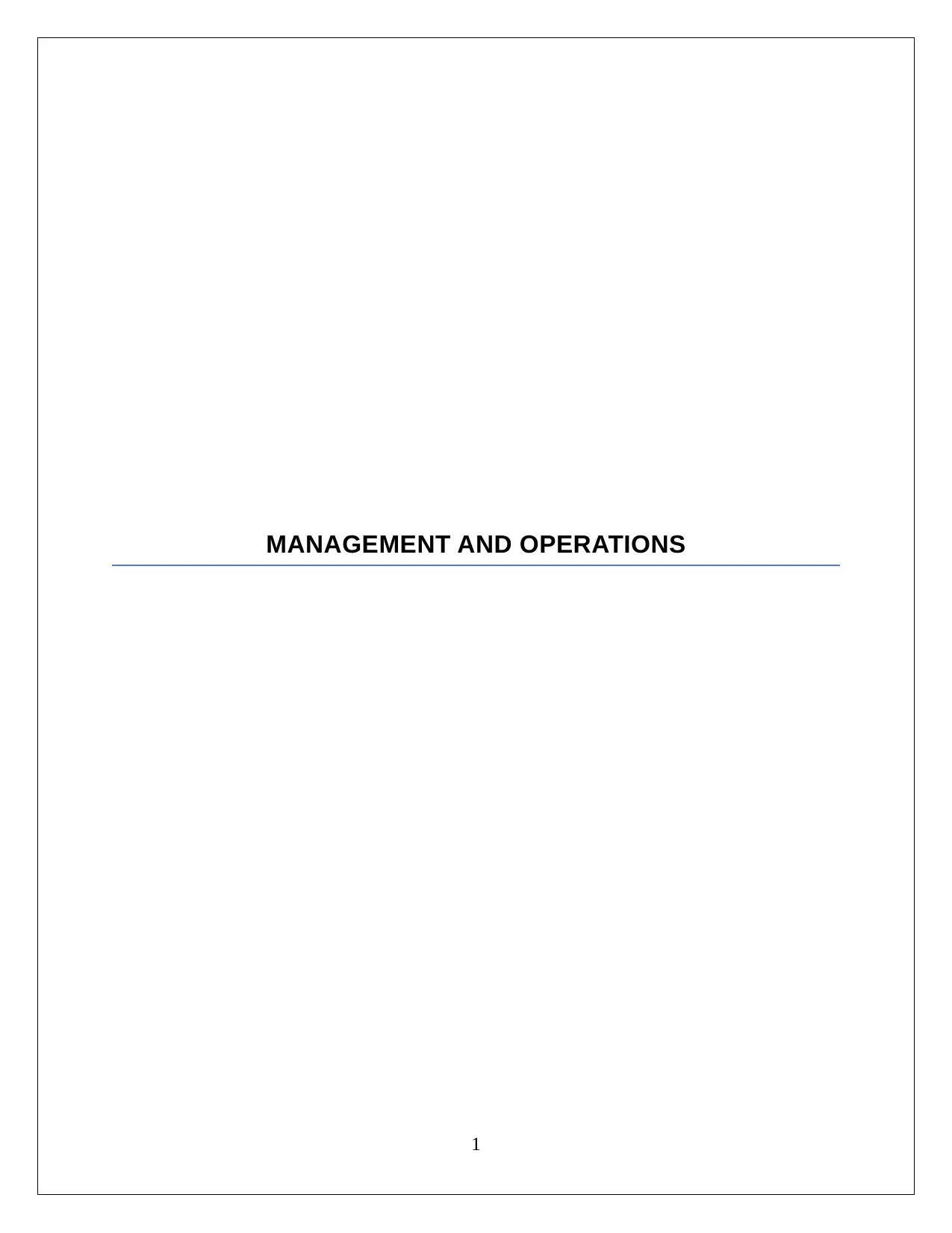
MANAGEMENT AND OPERATIONS
1
1
Paraphrase This Document
Need a fresh take? Get an instant paraphrase of this document with our AI Paraphraser
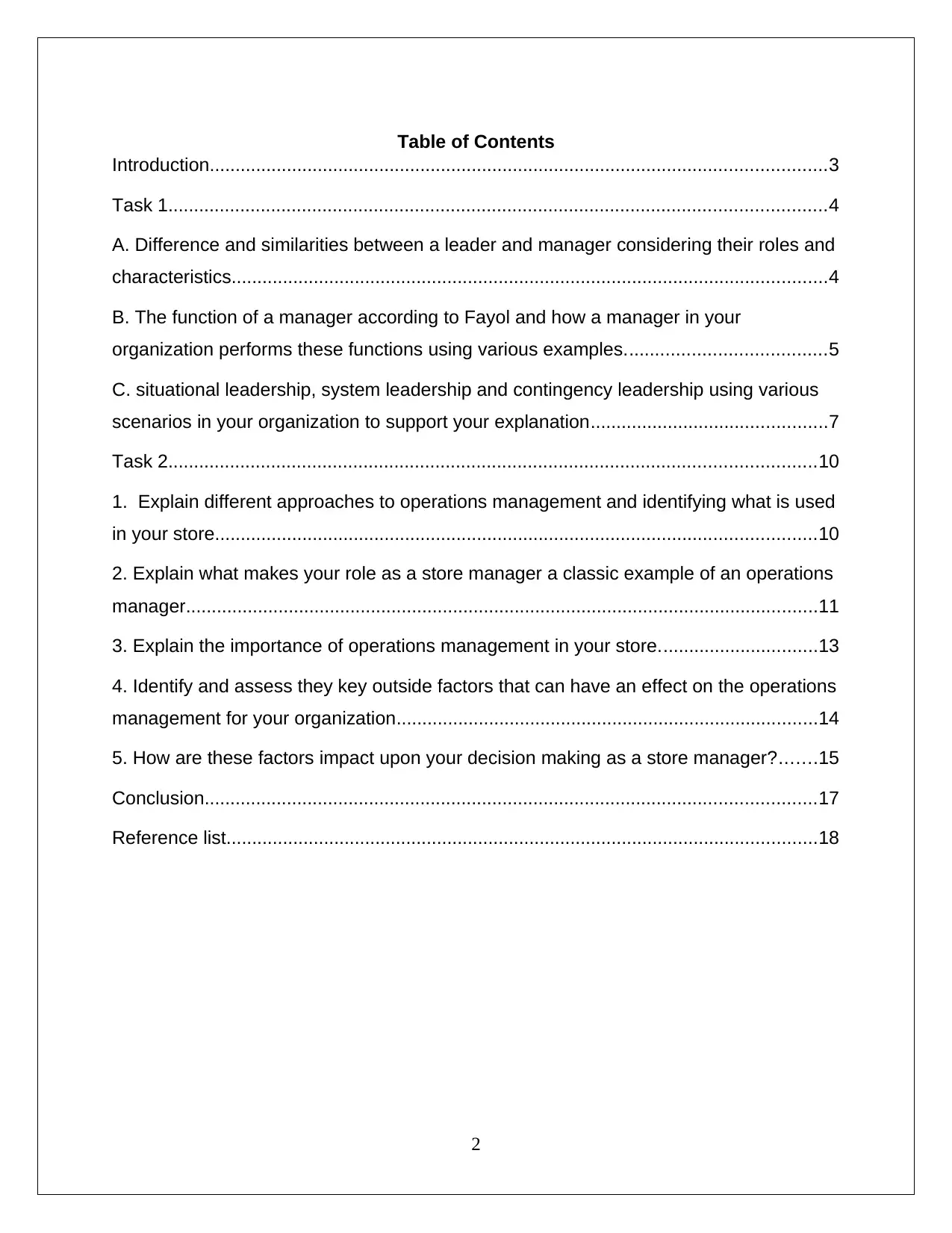
Table of Contents
Introduction........................................................................................................................3
Task 1................................................................................................................................4
A. Difference and similarities between a leader and manager considering their roles and
characteristics....................................................................................................................4
B. The function of a manager according to Fayol and how a manager in your
organization performs these functions using various examples.......................................5
C. situational leadership, system leadership and contingency leadership using various
scenarios in your organization to support your explanation..............................................7
Task 2..............................................................................................................................10
1. Explain different approaches to operations management and identifying what is used
in your store.....................................................................................................................10
2. Explain what makes your role as a store manager a classic example of an operations
manager...........................................................................................................................11
3. Explain the importance of operations management in your store...............................13
4. Identify and assess they key outside factors that can have an effect on the operations
management for your organization..................................................................................14
5. How are these factors impact upon your decision making as a store manager?.......15
Conclusion.......................................................................................................................17
Reference list...................................................................................................................18
2
Introduction........................................................................................................................3
Task 1................................................................................................................................4
A. Difference and similarities between a leader and manager considering their roles and
characteristics....................................................................................................................4
B. The function of a manager according to Fayol and how a manager in your
organization performs these functions using various examples.......................................5
C. situational leadership, system leadership and contingency leadership using various
scenarios in your organization to support your explanation..............................................7
Task 2..............................................................................................................................10
1. Explain different approaches to operations management and identifying what is used
in your store.....................................................................................................................10
2. Explain what makes your role as a store manager a classic example of an operations
manager...........................................................................................................................11
3. Explain the importance of operations management in your store...............................13
4. Identify and assess they key outside factors that can have an effect on the operations
management for your organization..................................................................................14
5. How are these factors impact upon your decision making as a store manager?.......15
Conclusion.......................................................................................................................17
Reference list...................................................................................................................18
2
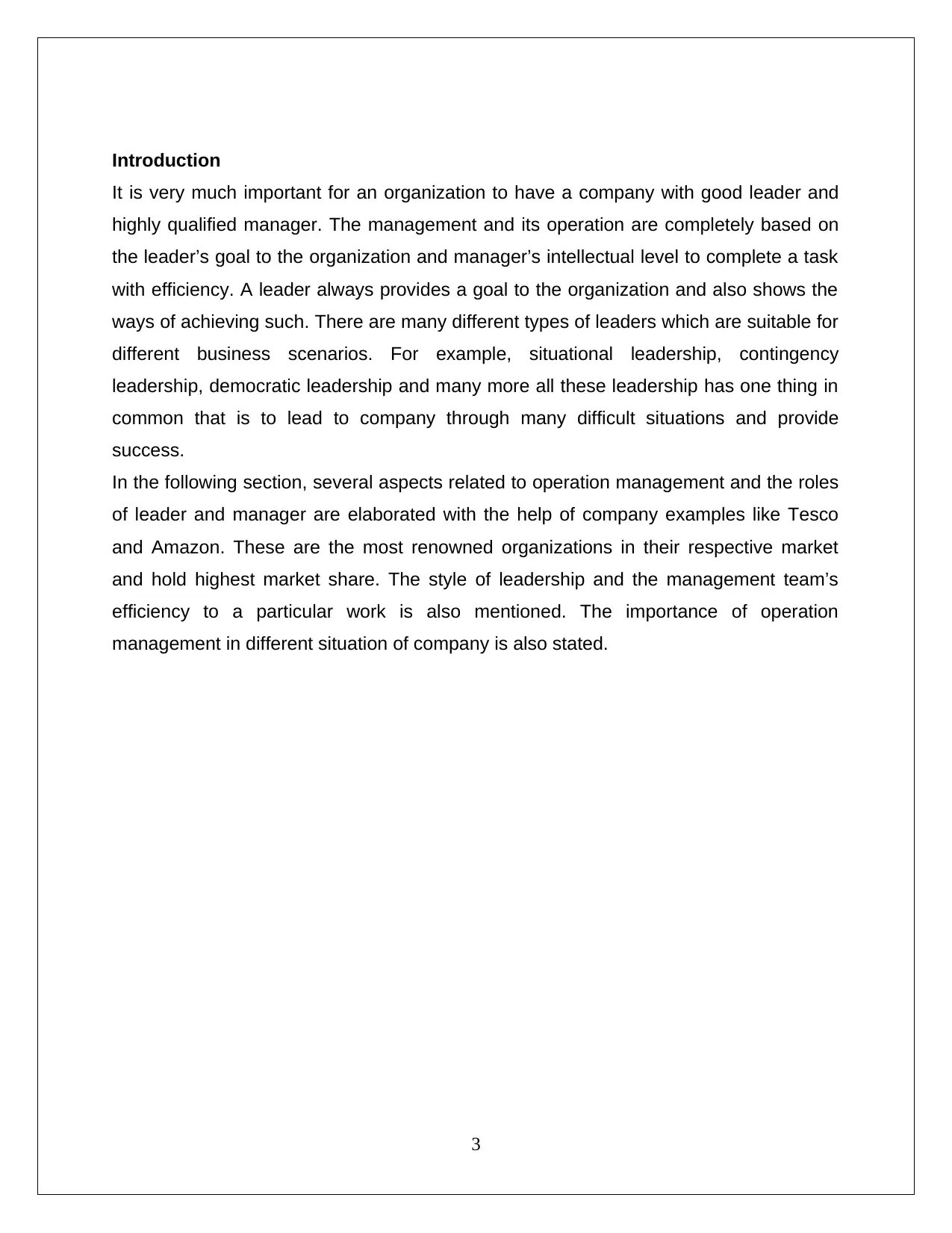
Introduction
It is very much important for an organization to have a company with good leader and
highly qualified manager. The management and its operation are completely based on
the leader’s goal to the organization and manager’s intellectual level to complete a task
with efficiency. A leader always provides a goal to the organization and also shows the
ways of achieving such. There are many different types of leaders which are suitable for
different business scenarios. For example, situational leadership, contingency
leadership, democratic leadership and many more all these leadership has one thing in
common that is to lead to company through many difficult situations and provide
success.
In the following section, several aspects related to operation management and the roles
of leader and manager are elaborated with the help of company examples like Tesco
and Amazon. These are the most renowned organizations in their respective market
and hold highest market share. The style of leadership and the management team’s
efficiency to a particular work is also mentioned. The importance of operation
management in different situation of company is also stated.
3
It is very much important for an organization to have a company with good leader and
highly qualified manager. The management and its operation are completely based on
the leader’s goal to the organization and manager’s intellectual level to complete a task
with efficiency. A leader always provides a goal to the organization and also shows the
ways of achieving such. There are many different types of leaders which are suitable for
different business scenarios. For example, situational leadership, contingency
leadership, democratic leadership and many more all these leadership has one thing in
common that is to lead to company through many difficult situations and provide
success.
In the following section, several aspects related to operation management and the roles
of leader and manager are elaborated with the help of company examples like Tesco
and Amazon. These are the most renowned organizations in their respective market
and hold highest market share. The style of leadership and the management team’s
efficiency to a particular work is also mentioned. The importance of operation
management in different situation of company is also stated.
3
⊘ This is a preview!⊘
Do you want full access?
Subscribe today to unlock all pages.

Trusted by 1+ million students worldwide
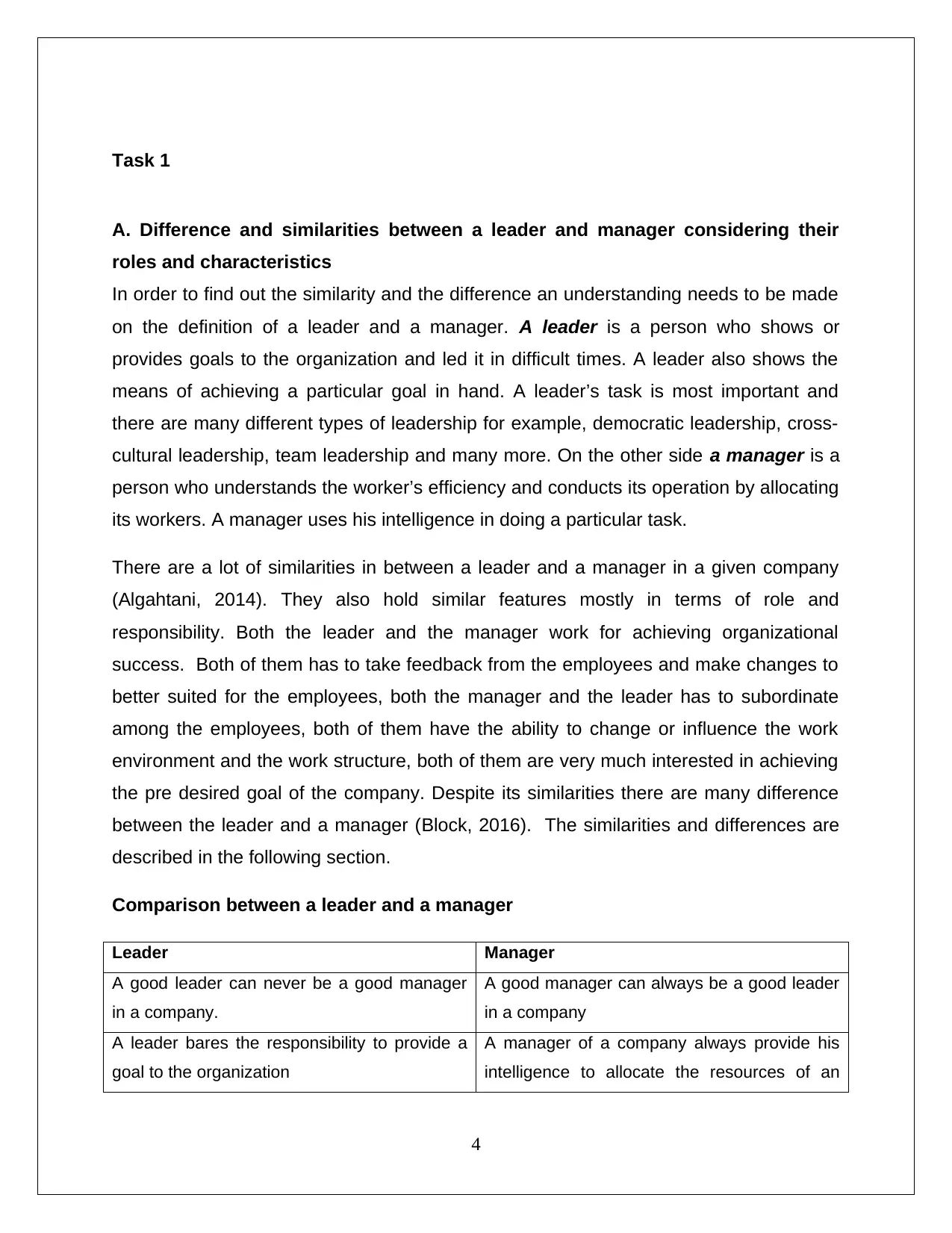
Task 1
A. Difference and similarities between a leader and manager considering their
roles and characteristics
In order to find out the similarity and the difference an understanding needs to be made
on the definition of a leader and a manager. A leader is a person who shows or
provides goals to the organization and led it in difficult times. A leader also shows the
means of achieving a particular goal in hand. A leader’s task is most important and
there are many different types of leadership for example, democratic leadership, cross-
cultural leadership, team leadership and many more. On the other side a manager is a
person who understands the worker’s efficiency and conducts its operation by allocating
its workers. A manager uses his intelligence in doing a particular task.
There are a lot of similarities in between a leader and a manager in a given company
(Algahtani, 2014). They also hold similar features mostly in terms of role and
responsibility. Both the leader and the manager work for achieving organizational
success. Both of them has to take feedback from the employees and make changes to
better suited for the employees, both the manager and the leader has to subordinate
among the employees, both of them have the ability to change or influence the work
environment and the work structure, both of them are very much interested in achieving
the pre desired goal of the company. Despite its similarities there are many difference
between the leader and a manager (Block, 2016). The similarities and differences are
described in the following section.
Comparison between a leader and a manager
Leader Manager
A good leader can never be a good manager
in a company.
A good manager can always be a good leader
in a company
A leader bares the responsibility to provide a
goal to the organization
A manager of a company always provide his
intelligence to allocate the resources of an
4
A. Difference and similarities between a leader and manager considering their
roles and characteristics
In order to find out the similarity and the difference an understanding needs to be made
on the definition of a leader and a manager. A leader is a person who shows or
provides goals to the organization and led it in difficult times. A leader also shows the
means of achieving a particular goal in hand. A leader’s task is most important and
there are many different types of leadership for example, democratic leadership, cross-
cultural leadership, team leadership and many more. On the other side a manager is a
person who understands the worker’s efficiency and conducts its operation by allocating
its workers. A manager uses his intelligence in doing a particular task.
There are a lot of similarities in between a leader and a manager in a given company
(Algahtani, 2014). They also hold similar features mostly in terms of role and
responsibility. Both the leader and the manager work for achieving organizational
success. Both of them has to take feedback from the employees and make changes to
better suited for the employees, both the manager and the leader has to subordinate
among the employees, both of them have the ability to change or influence the work
environment and the work structure, both of them are very much interested in achieving
the pre desired goal of the company. Despite its similarities there are many difference
between the leader and a manager (Block, 2016). The similarities and differences are
described in the following section.
Comparison between a leader and a manager
Leader Manager
A good leader can never be a good manager
in a company.
A good manager can always be a good leader
in a company
A leader bares the responsibility to provide a
goal to the organization
A manager of a company always provide his
intelligence to allocate the resources of an
4
Paraphrase This Document
Need a fresh take? Get an instant paraphrase of this document with our AI Paraphraser
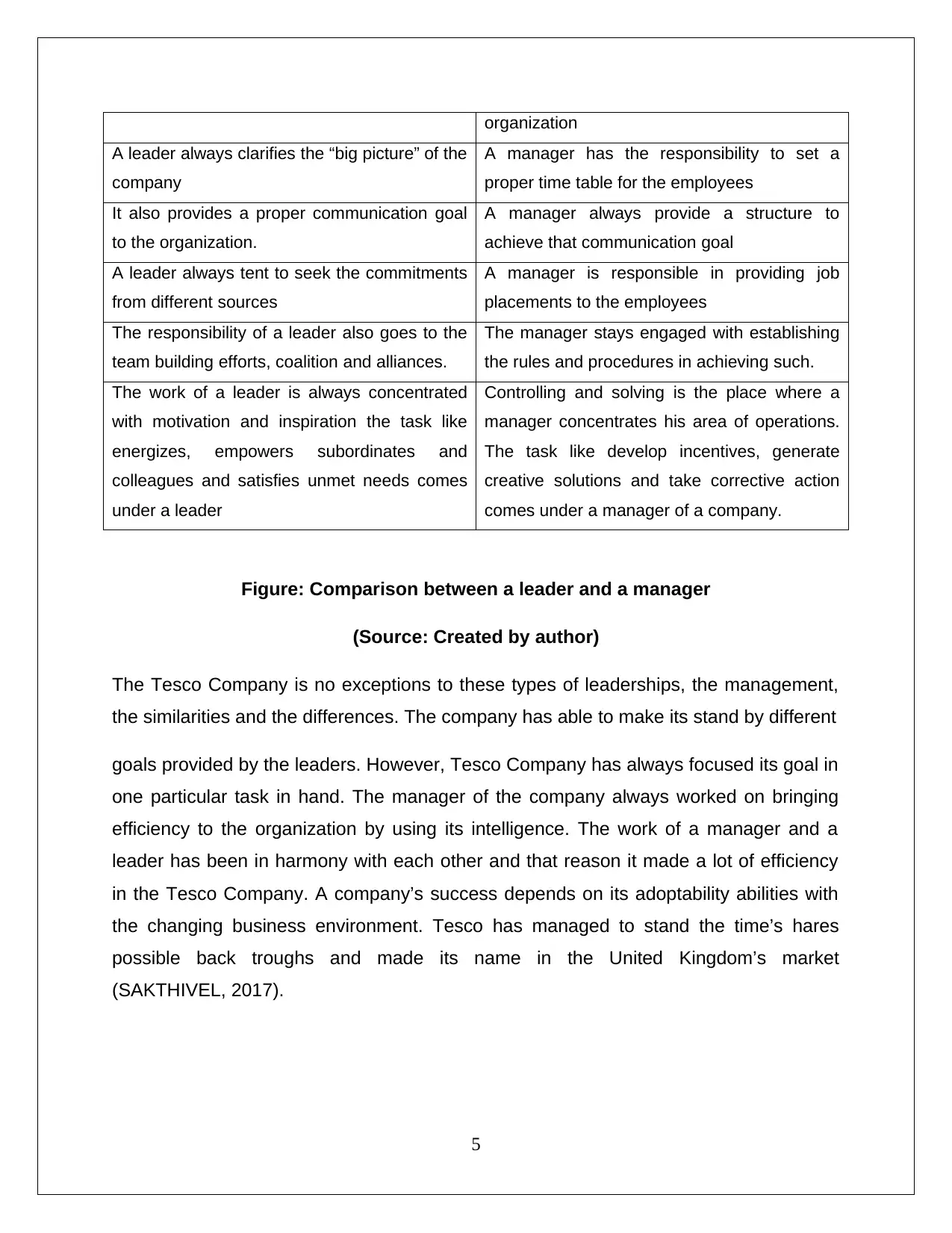
organization
A leader always clarifies the “big picture” of the
company
A manager has the responsibility to set a
proper time table for the employees
It also provides a proper communication goal
to the organization.
A manager always provide a structure to
achieve that communication goal
A leader always tent to seek the commitments
from different sources
A manager is responsible in providing job
placements to the employees
The responsibility of a leader also goes to the
team building efforts, coalition and alliances.
The manager stays engaged with establishing
the rules and procedures in achieving such.
The work of a leader is always concentrated
with motivation and inspiration the task like
energizes, empowers subordinates and
colleagues and satisfies unmet needs comes
under a leader
Controlling and solving is the place where a
manager concentrates his area of operations.
The task like develop incentives, generate
creative solutions and take corrective action
comes under a manager of a company.
Figure: Comparison between a leader and a manager
(Source: Created by author)
The Tesco Company is no exceptions to these types of leaderships, the management,
the similarities and the differences. The company has able to make its stand by different
goals provided by the leaders. However, Tesco Company has always focused its goal in
one particular task in hand. The manager of the company always worked on bringing
efficiency to the organization by using its intelligence. The work of a manager and a
leader has been in harmony with each other and that reason it made a lot of efficiency
in the Tesco Company. A company’s success depends on its adoptability abilities with
the changing business environment. Tesco has managed to stand the time’s hares
possible back troughs and made its name in the United Kingdom’s market
(SAKTHIVEL, 2017).
5
A leader always clarifies the “big picture” of the
company
A manager has the responsibility to set a
proper time table for the employees
It also provides a proper communication goal
to the organization.
A manager always provide a structure to
achieve that communication goal
A leader always tent to seek the commitments
from different sources
A manager is responsible in providing job
placements to the employees
The responsibility of a leader also goes to the
team building efforts, coalition and alliances.
The manager stays engaged with establishing
the rules and procedures in achieving such.
The work of a leader is always concentrated
with motivation and inspiration the task like
energizes, empowers subordinates and
colleagues and satisfies unmet needs comes
under a leader
Controlling and solving is the place where a
manager concentrates his area of operations.
The task like develop incentives, generate
creative solutions and take corrective action
comes under a manager of a company.
Figure: Comparison between a leader and a manager
(Source: Created by author)
The Tesco Company is no exceptions to these types of leaderships, the management,
the similarities and the differences. The company has able to make its stand by different
goals provided by the leaders. However, Tesco Company has always focused its goal in
one particular task in hand. The manager of the company always worked on bringing
efficiency to the organization by using its intelligence. The work of a manager and a
leader has been in harmony with each other and that reason it made a lot of efficiency
in the Tesco Company. A company’s success depends on its adoptability abilities with
the changing business environment. Tesco has managed to stand the time’s hares
possible back troughs and made its name in the United Kingdom’s market
(SAKTHIVEL, 2017).
5
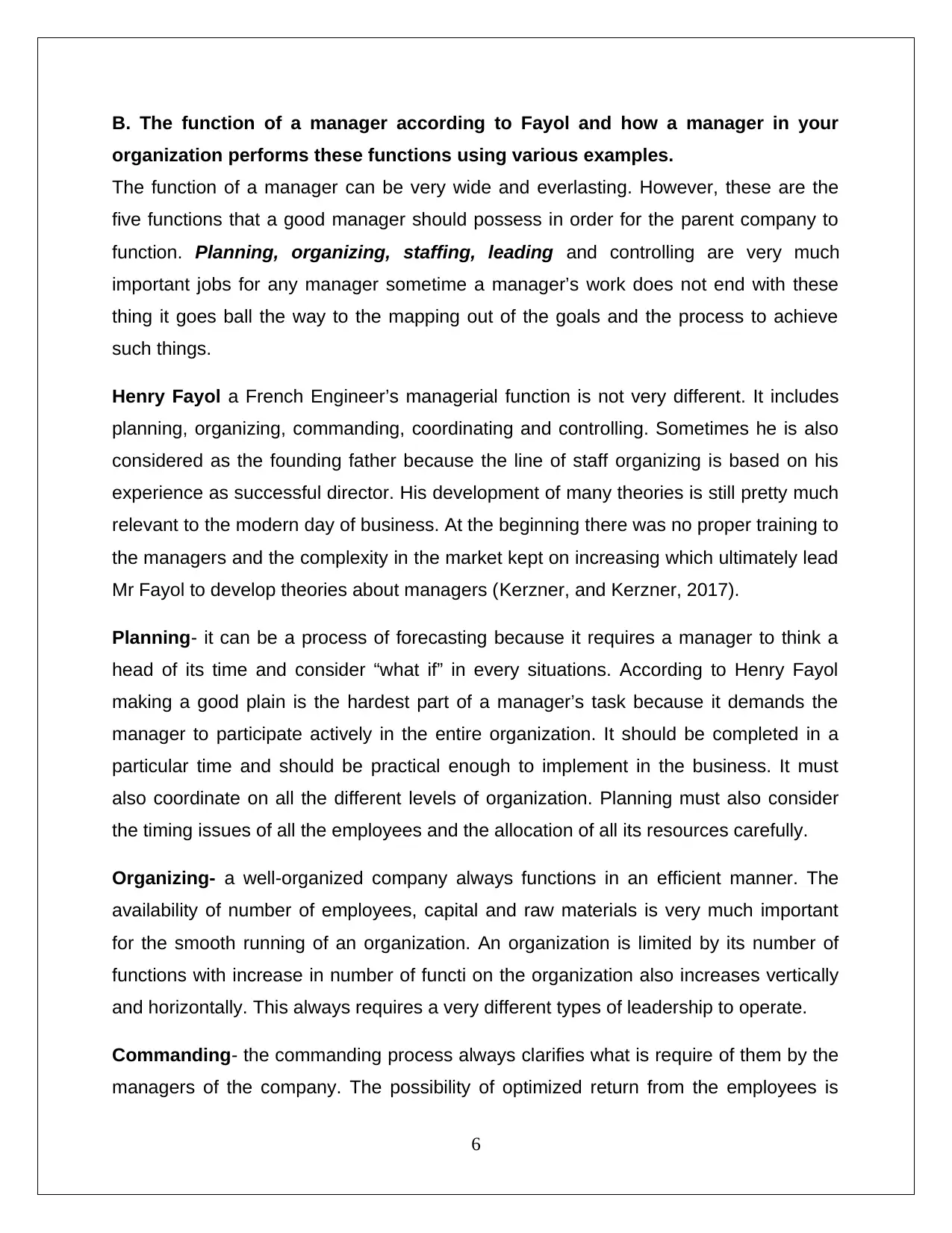
B. The function of a manager according to Fayol and how a manager in your
organization performs these functions using various examples.
The function of a manager can be very wide and everlasting. However, these are the
five functions that a good manager should possess in order for the parent company to
function. Planning, organizing, staffing, leading and controlling are very much
important jobs for any manager sometime a manager’s work does not end with these
thing it goes ball the way to the mapping out of the goals and the process to achieve
such things.
Henry Fayol a French Engineer’s managerial function is not very different. It includes
planning, organizing, commanding, coordinating and controlling. Sometimes he is also
considered as the founding father because the line of staff organizing is based on his
experience as successful director. His development of many theories is still pretty much
relevant to the modern day of business. At the beginning there was no proper training to
the managers and the complexity in the market kept on increasing which ultimately lead
Mr Fayol to develop theories about managers (Kerzner, and Kerzner, 2017).
Planning- it can be a process of forecasting because it requires a manager to think a
head of its time and consider “what if” in every situations. According to Henry Fayol
making a good plain is the hardest part of a manager’s task because it demands the
manager to participate actively in the entire organization. It should be completed in a
particular time and should be practical enough to implement in the business. It must
also coordinate on all the different levels of organization. Planning must also consider
the timing issues of all the employees and the allocation of all its resources carefully.
Organizing- a well-organized company always functions in an efficient manner. The
availability of number of employees, capital and raw materials is very much important
for the smooth running of an organization. An organization is limited by its number of
functions with increase in number of functi on the organization also increases vertically
and horizontally. This always requires a very different types of leadership to operate.
Commanding- the commanding process always clarifies what is require of them by the
managers of the company. The possibility of optimized return from the employees is
6
organization performs these functions using various examples.
The function of a manager can be very wide and everlasting. However, these are the
five functions that a good manager should possess in order for the parent company to
function. Planning, organizing, staffing, leading and controlling are very much
important jobs for any manager sometime a manager’s work does not end with these
thing it goes ball the way to the mapping out of the goals and the process to achieve
such things.
Henry Fayol a French Engineer’s managerial function is not very different. It includes
planning, organizing, commanding, coordinating and controlling. Sometimes he is also
considered as the founding father because the line of staff organizing is based on his
experience as successful director. His development of many theories is still pretty much
relevant to the modern day of business. At the beginning there was no proper training to
the managers and the complexity in the market kept on increasing which ultimately lead
Mr Fayol to develop theories about managers (Kerzner, and Kerzner, 2017).
Planning- it can be a process of forecasting because it requires a manager to think a
head of its time and consider “what if” in every situations. According to Henry Fayol
making a good plain is the hardest part of a manager’s task because it demands the
manager to participate actively in the entire organization. It should be completed in a
particular time and should be practical enough to implement in the business. It must
also coordinate on all the different levels of organization. Planning must also consider
the timing issues of all the employees and the allocation of all its resources carefully.
Organizing- a well-organized company always functions in an efficient manner. The
availability of number of employees, capital and raw materials is very much important
for the smooth running of an organization. An organization is limited by its number of
functions with increase in number of functi on the organization also increases vertically
and horizontally. This always requires a very different types of leadership to operate.
Commanding- the commanding process always clarifies what is require of them by the
managers of the company. The possibility of optimized return from the employees is
6
⊘ This is a preview!⊘
Do you want full access?
Subscribe today to unlock all pages.

Trusted by 1+ million students worldwide
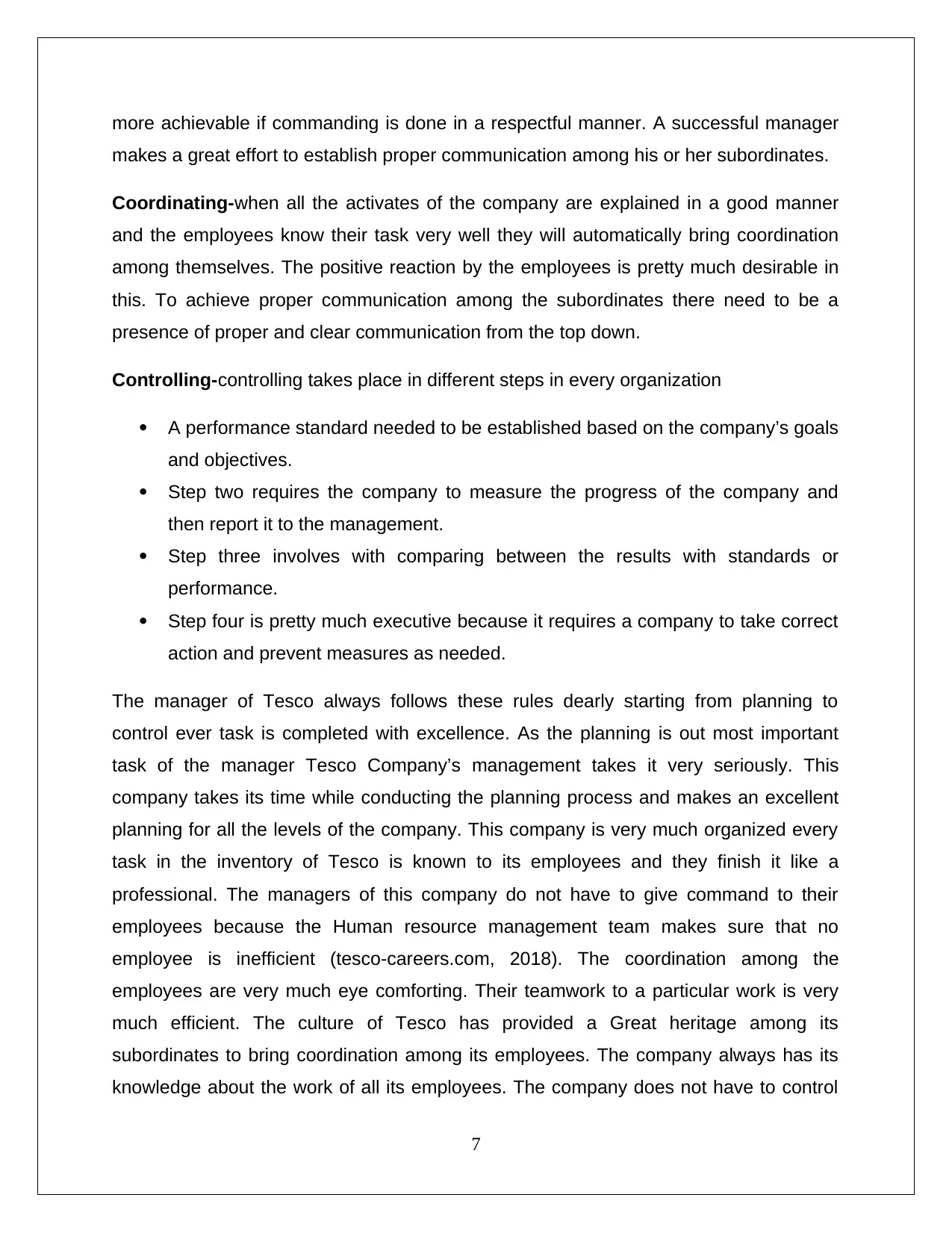
more achievable if commanding is done in a respectful manner. A successful manager
makes a great effort to establish proper communication among his or her subordinates.
Coordinating-when all the activates of the company are explained in a good manner
and the employees know their task very well they will automatically bring coordination
among themselves. The positive reaction by the employees is pretty much desirable in
this. To achieve proper communication among the subordinates there need to be a
presence of proper and clear communication from the top down.
Controlling-controlling takes place in different steps in every organization
A performance standard needed to be established based on the company’s goals
and objectives.
Step two requires the company to measure the progress of the company and
then report it to the management.
Step three involves with comparing between the results with standards or
performance.
Step four is pretty much executive because it requires a company to take correct
action and prevent measures as needed.
The manager of Tesco always follows these rules dearly starting from planning to
control ever task is completed with excellence. As the planning is out most important
task of the manager Tesco Company’s management takes it very seriously. This
company takes its time while conducting the planning process and makes an excellent
planning for all the levels of the company. This company is very much organized every
task in the inventory of Tesco is known to its employees and they finish it like a
professional. The managers of this company do not have to give command to their
employees because the Human resource management team makes sure that no
employee is inefficient (tesco-careers.com, 2018). The coordination among the
employees are very much eye comforting. Their teamwork to a particular work is very
much efficient. The culture of Tesco has provided a Great heritage among its
subordinates to bring coordination among its employees. The company always has its
knowledge about the work of all its employees. The company does not have to control
7
makes a great effort to establish proper communication among his or her subordinates.
Coordinating-when all the activates of the company are explained in a good manner
and the employees know their task very well they will automatically bring coordination
among themselves. The positive reaction by the employees is pretty much desirable in
this. To achieve proper communication among the subordinates there need to be a
presence of proper and clear communication from the top down.
Controlling-controlling takes place in different steps in every organization
A performance standard needed to be established based on the company’s goals
and objectives.
Step two requires the company to measure the progress of the company and
then report it to the management.
Step three involves with comparing between the results with standards or
performance.
Step four is pretty much executive because it requires a company to take correct
action and prevent measures as needed.
The manager of Tesco always follows these rules dearly starting from planning to
control ever task is completed with excellence. As the planning is out most important
task of the manager Tesco Company’s management takes it very seriously. This
company takes its time while conducting the planning process and makes an excellent
planning for all the levels of the company. This company is very much organized every
task in the inventory of Tesco is known to its employees and they finish it like a
professional. The managers of this company do not have to give command to their
employees because the Human resource management team makes sure that no
employee is inefficient (tesco-careers.com, 2018). The coordination among the
employees are very much eye comforting. Their teamwork to a particular work is very
much efficient. The culture of Tesco has provided a Great heritage among its
subordinates to bring coordination among its employees. The company always has its
knowledge about the work of all its employees. The company does not have to control
7
Paraphrase This Document
Need a fresh take? Get an instant paraphrase of this document with our AI Paraphraser
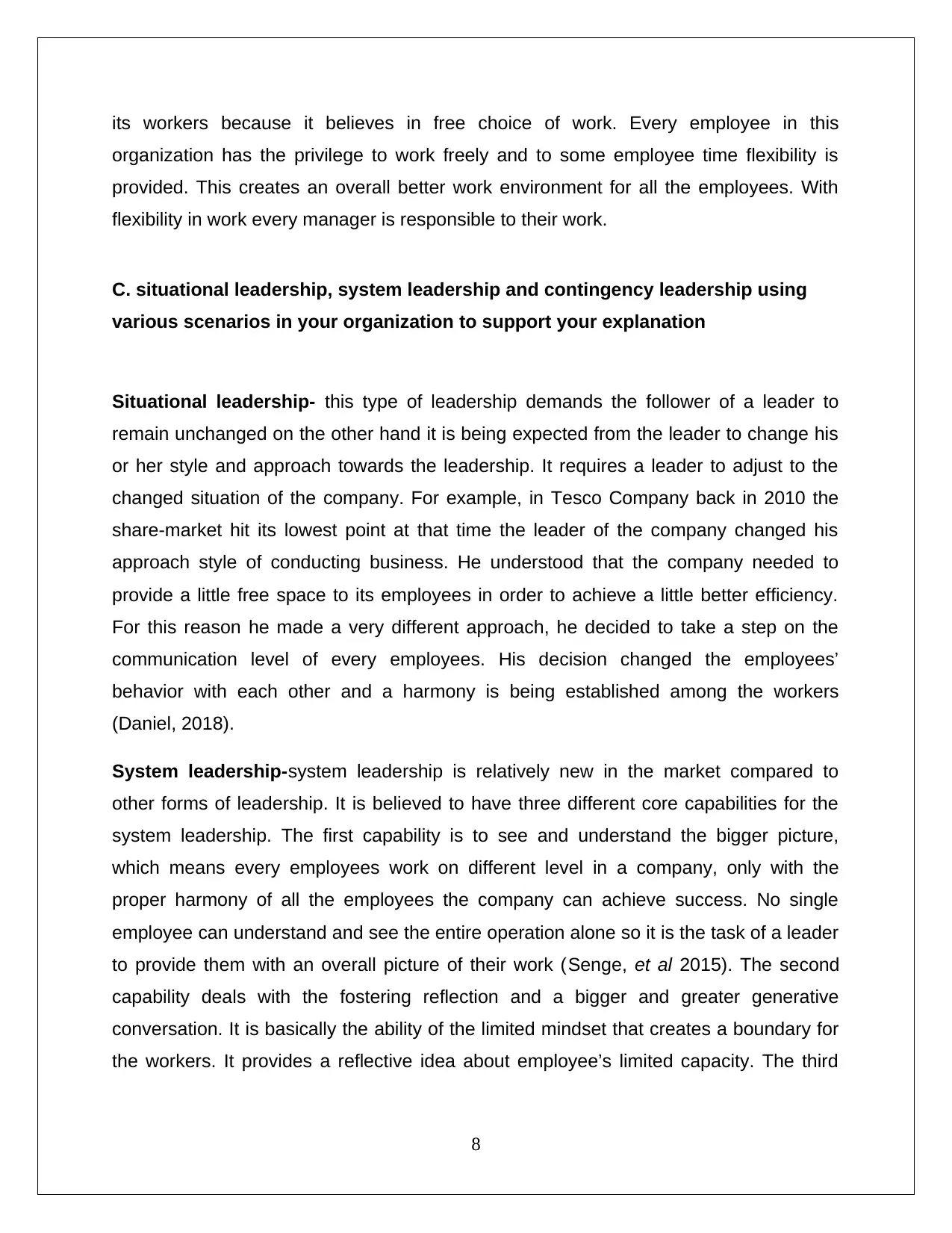
its workers because it believes in free choice of work. Every employee in this
organization has the privilege to work freely and to some employee time flexibility is
provided. This creates an overall better work environment for all the employees. With
flexibility in work every manager is responsible to their work.
C. situational leadership, system leadership and contingency leadership using
various scenarios in your organization to support your explanation
Situational leadership- this type of leadership demands the follower of a leader to
remain unchanged on the other hand it is being expected from the leader to change his
or her style and approach towards the leadership. It requires a leader to adjust to the
changed situation of the company. For example, in Tesco Company back in 2010 the
share-market hit its lowest point at that time the leader of the company changed his
approach style of conducting business. He understood that the company needed to
provide a little free space to its employees in order to achieve a little better efficiency.
For this reason he made a very different approach, he decided to take a step on the
communication level of every employees. His decision changed the employees’
behavior with each other and a harmony is being established among the workers
(Daniel, 2018).
System leadership-system leadership is relatively new in the market compared to
other forms of leadership. It is believed to have three different core capabilities for the
system leadership. The first capability is to see and understand the bigger picture,
which means every employees work on different level in a company, only with the
proper harmony of all the employees the company can achieve success. No single
employee can understand and see the entire operation alone so it is the task of a leader
to provide them with an overall picture of their work (Senge, et al 2015). The second
capability deals with the fostering reflection and a bigger and greater generative
conversation. It is basically the ability of the limited mindset that creates a boundary for
the workers. It provides a reflective idea about employee’s limited capacity. The third
8
organization has the privilege to work freely and to some employee time flexibility is
provided. This creates an overall better work environment for all the employees. With
flexibility in work every manager is responsible to their work.
C. situational leadership, system leadership and contingency leadership using
various scenarios in your organization to support your explanation
Situational leadership- this type of leadership demands the follower of a leader to
remain unchanged on the other hand it is being expected from the leader to change his
or her style and approach towards the leadership. It requires a leader to adjust to the
changed situation of the company. For example, in Tesco Company back in 2010 the
share-market hit its lowest point at that time the leader of the company changed his
approach style of conducting business. He understood that the company needed to
provide a little free space to its employees in order to achieve a little better efficiency.
For this reason he made a very different approach, he decided to take a step on the
communication level of every employees. His decision changed the employees’
behavior with each other and a harmony is being established among the workers
(Daniel, 2018).
System leadership-system leadership is relatively new in the market compared to
other forms of leadership. It is believed to have three different core capabilities for the
system leadership. The first capability is to see and understand the bigger picture,
which means every employees work on different level in a company, only with the
proper harmony of all the employees the company can achieve success. No single
employee can understand and see the entire operation alone so it is the task of a leader
to provide them with an overall picture of their work (Senge, et al 2015). The second
capability deals with the fostering reflection and a bigger and greater generative
conversation. It is basically the ability of the limited mindset that creates a boundary for
the workers. It provides a reflective idea about employee’s limited capacity. The third
8
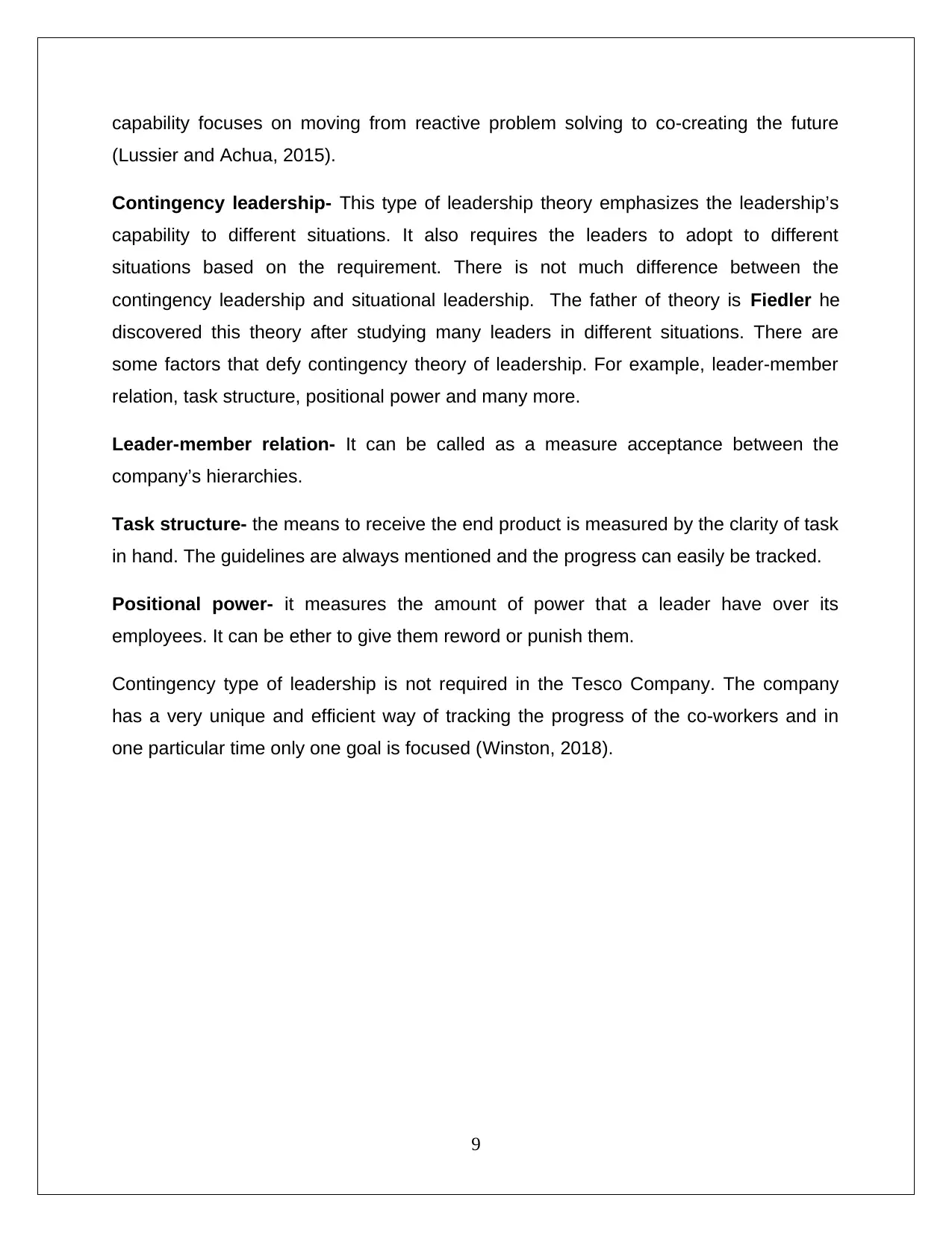
capability focuses on moving from reactive problem solving to co-creating the future
(Lussier and Achua, 2015).
Contingency leadership- This type of leadership theory emphasizes the leadership’s
capability to different situations. It also requires the leaders to adopt to different
situations based on the requirement. There is not much difference between the
contingency leadership and situational leadership. The father of theory is Fiedler he
discovered this theory after studying many leaders in different situations. There are
some factors that defy contingency theory of leadership. For example, leader-member
relation, task structure, positional power and many more.
Leader-member relation- It can be called as a measure acceptance between the
company’s hierarchies.
Task structure- the means to receive the end product is measured by the clarity of task
in hand. The guidelines are always mentioned and the progress can easily be tracked.
Positional power- it measures the amount of power that a leader have over its
employees. It can be ether to give them reword or punish them.
Contingency type of leadership is not required in the Tesco Company. The company
has a very unique and efficient way of tracking the progress of the co-workers and in
one particular time only one goal is focused (Winston, 2018).
9
(Lussier and Achua, 2015).
Contingency leadership- This type of leadership theory emphasizes the leadership’s
capability to different situations. It also requires the leaders to adopt to different
situations based on the requirement. There is not much difference between the
contingency leadership and situational leadership. The father of theory is Fiedler he
discovered this theory after studying many leaders in different situations. There are
some factors that defy contingency theory of leadership. For example, leader-member
relation, task structure, positional power and many more.
Leader-member relation- It can be called as a measure acceptance between the
company’s hierarchies.
Task structure- the means to receive the end product is measured by the clarity of task
in hand. The guidelines are always mentioned and the progress can easily be tracked.
Positional power- it measures the amount of power that a leader have over its
employees. It can be ether to give them reword or punish them.
Contingency type of leadership is not required in the Tesco Company. The company
has a very unique and efficient way of tracking the progress of the co-workers and in
one particular time only one goal is focused (Winston, 2018).
9
⊘ This is a preview!⊘
Do you want full access?
Subscribe today to unlock all pages.

Trusted by 1+ million students worldwide
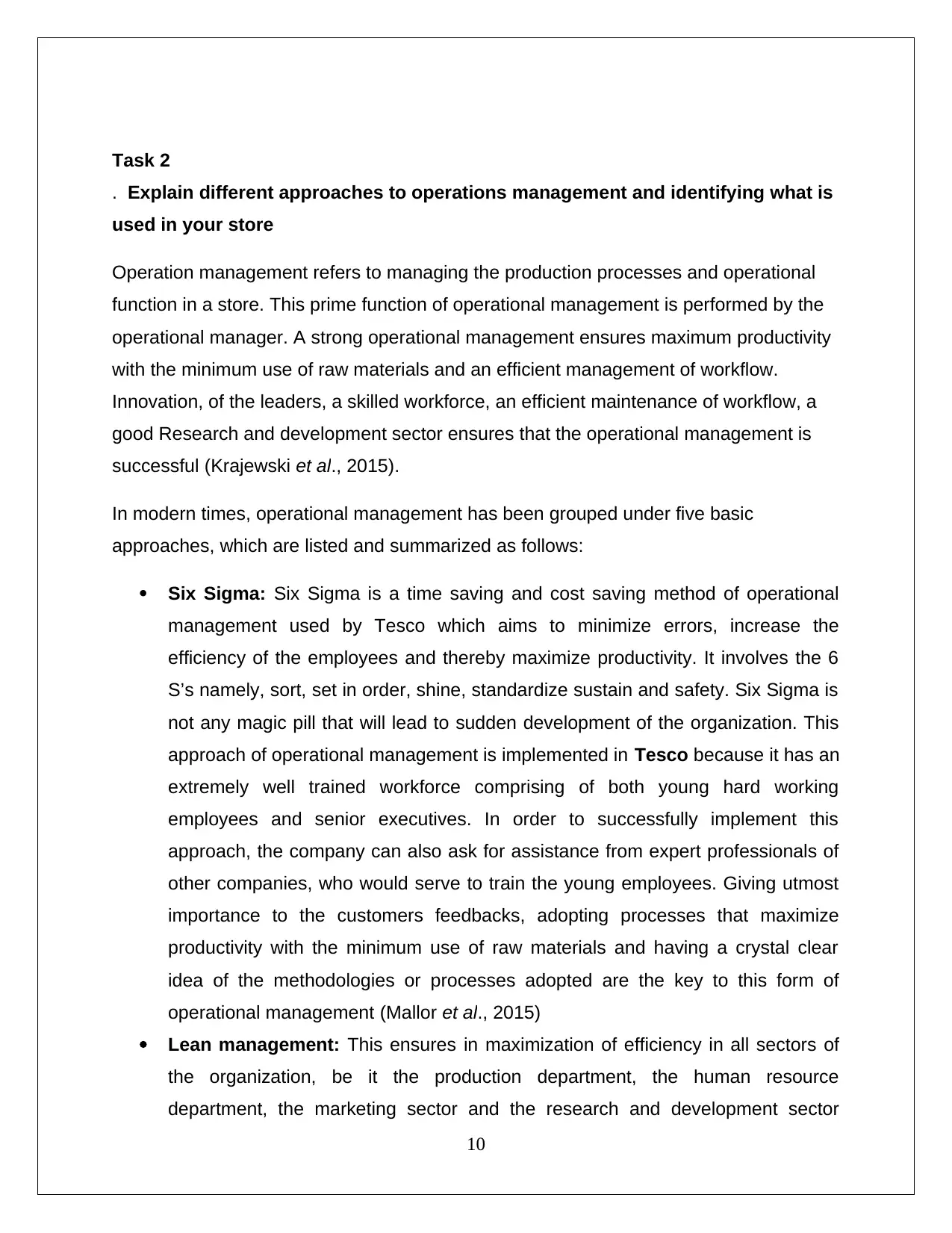
Task 2
. Explain different approaches to operations management and identifying what is
used in your store
Operation management refers to managing the production processes and operational
function in a store. This prime function of operational management is performed by the
operational manager. A strong operational management ensures maximum productivity
with the minimum use of raw materials and an efficient management of workflow.
Innovation, of the leaders, a skilled workforce, an efficient maintenance of workflow, a
good Research and development sector ensures that the operational management is
successful (Krajewski et al., 2015).
In modern times, operational management has been grouped under five basic
approaches, which are listed and summarized as follows:
Six Sigma: Six Sigma is a time saving and cost saving method of operational
management used by Tesco which aims to minimize errors, increase the
efficiency of the employees and thereby maximize productivity. It involves the 6
S’s namely, sort, set in order, shine, standardize sustain and safety. Six Sigma is
not any magic pill that will lead to sudden development of the organization. This
approach of operational management is implemented in Tesco because it has an
extremely well trained workforce comprising of both young hard working
employees and senior executives. In order to successfully implement this
approach, the company can also ask for assistance from expert professionals of
other companies, who would serve to train the young employees. Giving utmost
importance to the customers feedbacks, adopting processes that maximize
productivity with the minimum use of raw materials and having a crystal clear
idea of the methodologies or processes adopted are the key to this form of
operational management (Mallor et al., 2015)
Lean management: This ensures in maximization of efficiency in all sectors of
the organization, be it the production department, the human resource
department, the marketing sector and the research and development sector
10
. Explain different approaches to operations management and identifying what is
used in your store
Operation management refers to managing the production processes and operational
function in a store. This prime function of operational management is performed by the
operational manager. A strong operational management ensures maximum productivity
with the minimum use of raw materials and an efficient management of workflow.
Innovation, of the leaders, a skilled workforce, an efficient maintenance of workflow, a
good Research and development sector ensures that the operational management is
successful (Krajewski et al., 2015).
In modern times, operational management has been grouped under five basic
approaches, which are listed and summarized as follows:
Six Sigma: Six Sigma is a time saving and cost saving method of operational
management used by Tesco which aims to minimize errors, increase the
efficiency of the employees and thereby maximize productivity. It involves the 6
S’s namely, sort, set in order, shine, standardize sustain and safety. Six Sigma is
not any magic pill that will lead to sudden development of the organization. This
approach of operational management is implemented in Tesco because it has an
extremely well trained workforce comprising of both young hard working
employees and senior executives. In order to successfully implement this
approach, the company can also ask for assistance from expert professionals of
other companies, who would serve to train the young employees. Giving utmost
importance to the customers feedbacks, adopting processes that maximize
productivity with the minimum use of raw materials and having a crystal clear
idea of the methodologies or processes adopted are the key to this form of
operational management (Mallor et al., 2015)
Lean management: This ensures in maximization of efficiency in all sectors of
the organization, be it the production department, the human resource
department, the marketing sector and the research and development sector
10
Paraphrase This Document
Need a fresh take? Get an instant paraphrase of this document with our AI Paraphraser
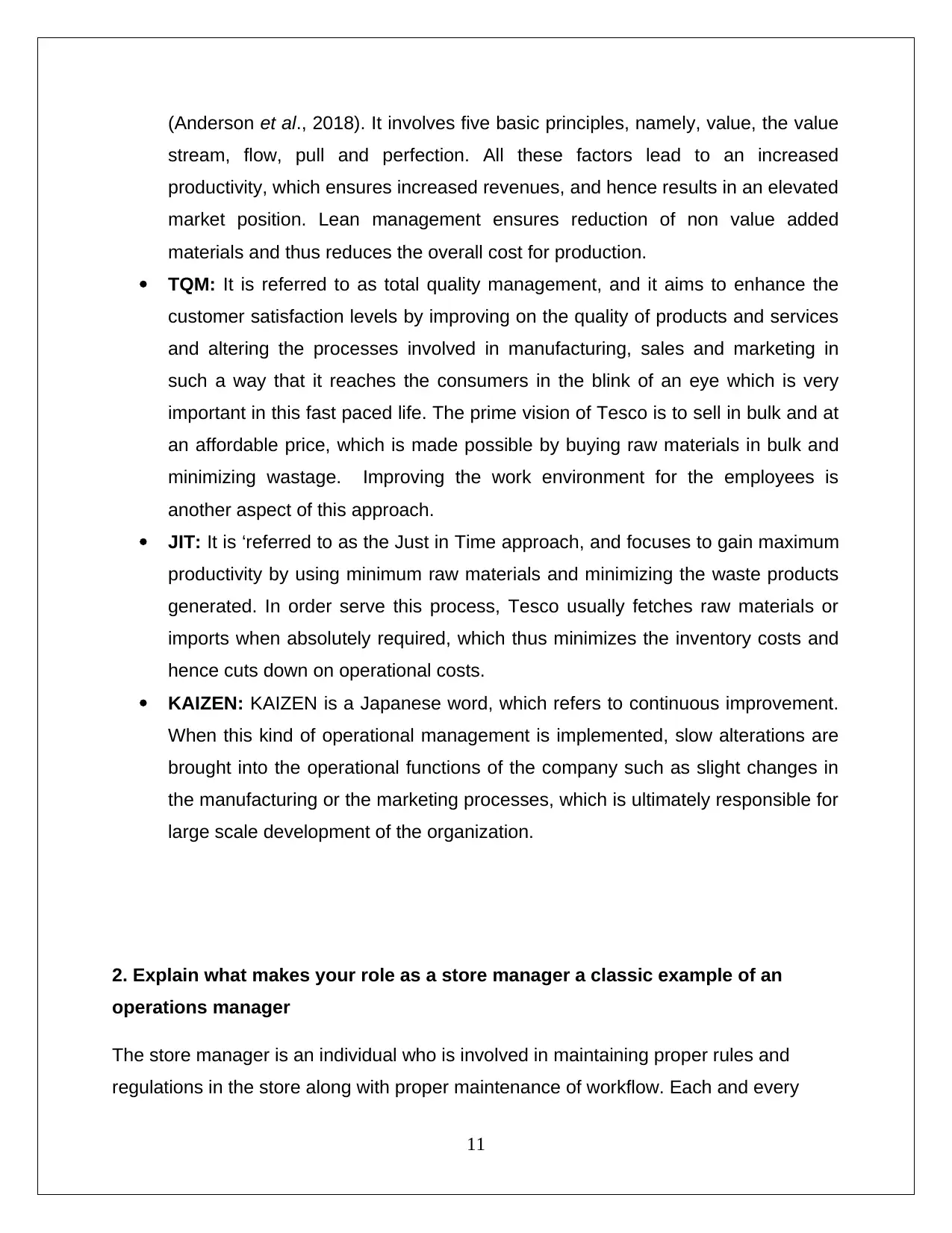
(Anderson et al., 2018). It involves five basic principles, namely, value, the value
stream, flow, pull and perfection. All these factors lead to an increased
productivity, which ensures increased revenues, and hence results in an elevated
market position. Lean management ensures reduction of non value added
materials and thus reduces the overall cost for production.
TQM: It is referred to as total quality management, and it aims to enhance the
customer satisfaction levels by improving on the quality of products and services
and altering the processes involved in manufacturing, sales and marketing in
such a way that it reaches the consumers in the blink of an eye which is very
important in this fast paced life. The prime vision of Tesco is to sell in bulk and at
an affordable price, which is made possible by buying raw materials in bulk and
minimizing wastage. Improving the work environment for the employees is
another aspect of this approach.
JIT: It is ‘referred to as the Just in Time approach, and focuses to gain maximum
productivity by using minimum raw materials and minimizing the waste products
generated. In order serve this process, Tesco usually fetches raw materials or
imports when absolutely required, which thus minimizes the inventory costs and
hence cuts down on operational costs.
KAIZEN: KAIZEN is a Japanese word, which refers to continuous improvement.
When this kind of operational management is implemented, slow alterations are
brought into the operational functions of the company such as slight changes in
the manufacturing or the marketing processes, which is ultimately responsible for
large scale development of the organization.
2. Explain what makes your role as a store manager a classic example of an
operations manager
The store manager is an individual who is involved in maintaining proper rules and
regulations in the store along with proper maintenance of workflow. Each and every
11
stream, flow, pull and perfection. All these factors lead to an increased
productivity, which ensures increased revenues, and hence results in an elevated
market position. Lean management ensures reduction of non value added
materials and thus reduces the overall cost for production.
TQM: It is referred to as total quality management, and it aims to enhance the
customer satisfaction levels by improving on the quality of products and services
and altering the processes involved in manufacturing, sales and marketing in
such a way that it reaches the consumers in the blink of an eye which is very
important in this fast paced life. The prime vision of Tesco is to sell in bulk and at
an affordable price, which is made possible by buying raw materials in bulk and
minimizing wastage. Improving the work environment for the employees is
another aspect of this approach.
JIT: It is ‘referred to as the Just in Time approach, and focuses to gain maximum
productivity by using minimum raw materials and minimizing the waste products
generated. In order serve this process, Tesco usually fetches raw materials or
imports when absolutely required, which thus minimizes the inventory costs and
hence cuts down on operational costs.
KAIZEN: KAIZEN is a Japanese word, which refers to continuous improvement.
When this kind of operational management is implemented, slow alterations are
brought into the operational functions of the company such as slight changes in
the manufacturing or the marketing processes, which is ultimately responsible for
large scale development of the organization.
2. Explain what makes your role as a store manager a classic example of an
operations manager
The store manager is an individual who is involved in maintaining proper rules and
regulations in the store along with proper maintenance of workflow. Each and every
11
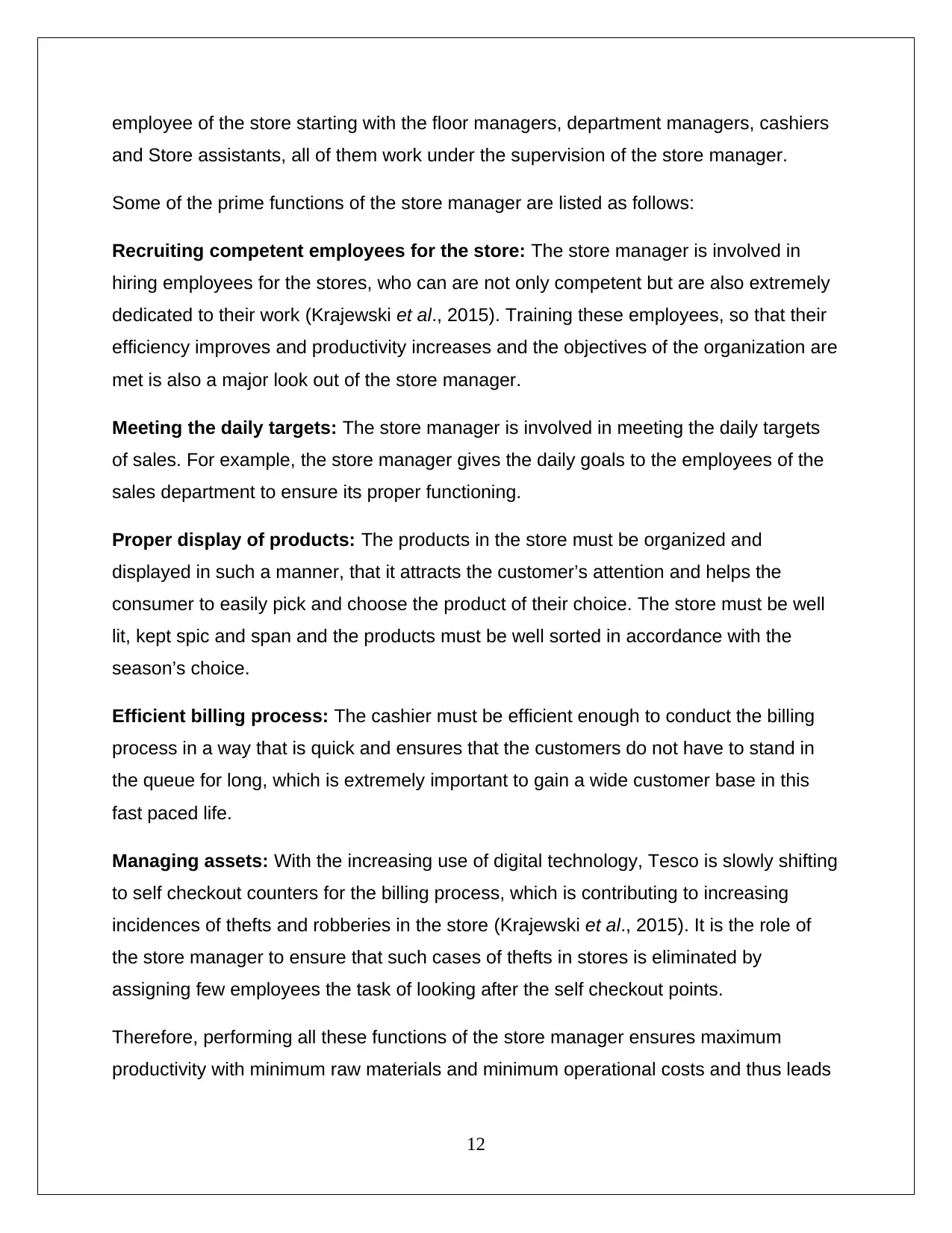
employee of the store starting with the floor managers, department managers, cashiers
and Store assistants, all of them work under the supervision of the store manager.
Some of the prime functions of the store manager are listed as follows:
Recruiting competent employees for the store: The store manager is involved in
hiring employees for the stores, who can are not only competent but are also extremely
dedicated to their work (Krajewski et al., 2015). Training these employees, so that their
efficiency improves and productivity increases and the objectives of the organization are
met is also a major look out of the store manager.
Meeting the daily targets: The store manager is involved in meeting the daily targets
of sales. For example, the store manager gives the daily goals to the employees of the
sales department to ensure its proper functioning.
Proper display of products: The products in the store must be organized and
displayed in such a manner, that it attracts the customer’s attention and helps the
consumer to easily pick and choose the product of their choice. The store must be well
lit, kept spic and span and the products must be well sorted in accordance with the
season’s choice.
Efficient billing process: The cashier must be efficient enough to conduct the billing
process in a way that is quick and ensures that the customers do not have to stand in
the queue for long, which is extremely important to gain a wide customer base in this
fast paced life.
Managing assets: With the increasing use of digital technology, Tesco is slowly shifting
to self checkout counters for the billing process, which is contributing to increasing
incidences of thefts and robberies in the store (Krajewski et al., 2015). It is the role of
the store manager to ensure that such cases of thefts in stores is eliminated by
assigning few employees the task of looking after the self checkout points.
Therefore, performing all these functions of the store manager ensures maximum
productivity with minimum raw materials and minimum operational costs and thus leads
12
and Store assistants, all of them work under the supervision of the store manager.
Some of the prime functions of the store manager are listed as follows:
Recruiting competent employees for the store: The store manager is involved in
hiring employees for the stores, who can are not only competent but are also extremely
dedicated to their work (Krajewski et al., 2015). Training these employees, so that their
efficiency improves and productivity increases and the objectives of the organization are
met is also a major look out of the store manager.
Meeting the daily targets: The store manager is involved in meeting the daily targets
of sales. For example, the store manager gives the daily goals to the employees of the
sales department to ensure its proper functioning.
Proper display of products: The products in the store must be organized and
displayed in such a manner, that it attracts the customer’s attention and helps the
consumer to easily pick and choose the product of their choice. The store must be well
lit, kept spic and span and the products must be well sorted in accordance with the
season’s choice.
Efficient billing process: The cashier must be efficient enough to conduct the billing
process in a way that is quick and ensures that the customers do not have to stand in
the queue for long, which is extremely important to gain a wide customer base in this
fast paced life.
Managing assets: With the increasing use of digital technology, Tesco is slowly shifting
to self checkout counters for the billing process, which is contributing to increasing
incidences of thefts and robberies in the store (Krajewski et al., 2015). It is the role of
the store manager to ensure that such cases of thefts in stores is eliminated by
assigning few employees the task of looking after the self checkout points.
Therefore, performing all these functions of the store manager ensures maximum
productivity with minimum raw materials and minimum operational costs and thus leads
12
⊘ This is a preview!⊘
Do you want full access?
Subscribe today to unlock all pages.

Trusted by 1+ million students worldwide
1 out of 19
Related Documents
Your All-in-One AI-Powered Toolkit for Academic Success.
+13062052269
info@desklib.com
Available 24*7 on WhatsApp / Email
![[object Object]](/_next/static/media/star-bottom.7253800d.svg)
Unlock your academic potential
Copyright © 2020–2025 A2Z Services. All Rights Reserved. Developed and managed by ZUCOL.




